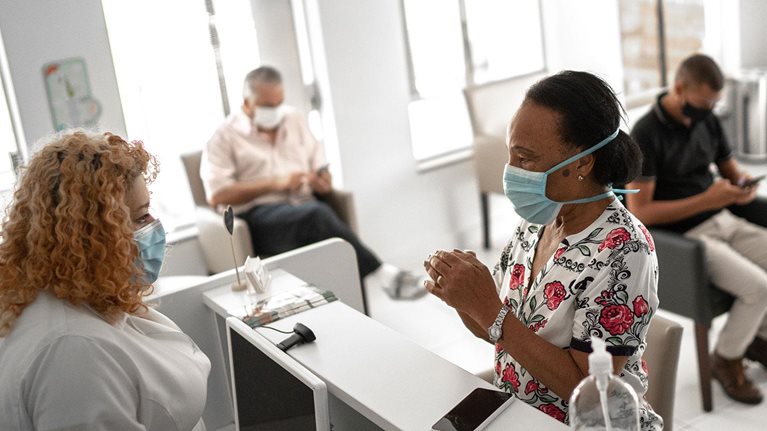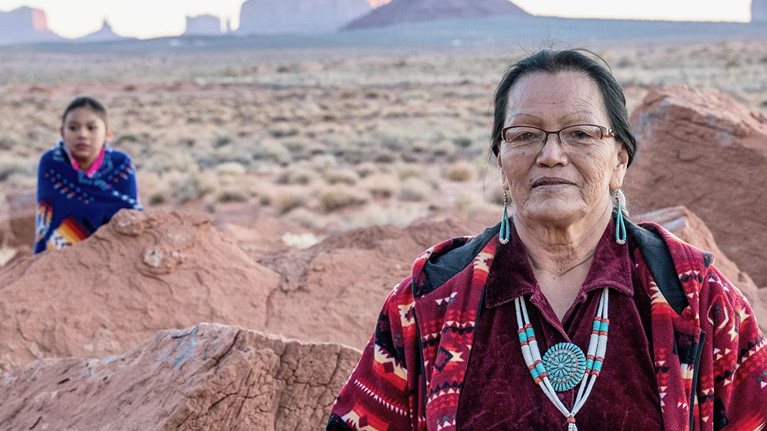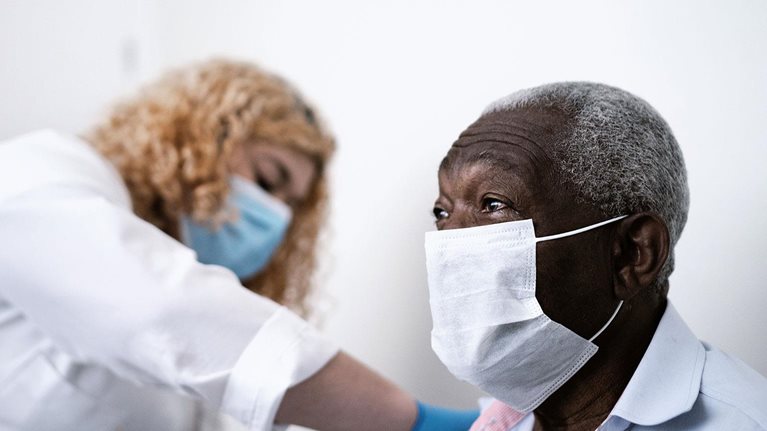Shifting constraints present a fork in the road
Thus far, COVID-19 vaccine supply has played a role in limiting total access to a shot in all arms.1 Manufacturers are now on track to supply enough doses for all adults in the United States by end of May 2021.2 However, without a focus on issues spanning consumer education to logistics of access points, adequate supply will not likely lead to the end of the pandemic. Current administration architecture and consumer demand are not on pace to match supply and would need to be ramped up almost two-fold in order to reach 80 percent coverage by May (Exhibit 1). Meanwhile, at current 14-day-average administration rates, the United States is not on track to reach 80 percent coverage until mid-July, several months after enough vaccine doses are available to cover the total adult population (Exhibit 1).

As manufacturers continue fulfilling their contracted dose commitments, the barrier to achieve herd immunity will soon shift from supply constraints to limitations in consumer demand and administration capacity. How well state and federal stakeholders address these two areas may determine the next stretch of the pandemic. As of now, America faces a potentially slow phase over the next two months to cover the remaining 210 million eligible Americans who have yet to receive a full vaccination course.3 Likewise, demand constraints have already begun affecting vaccination rates in some places, with states such as Alabama administering only 62 percent of allocated doses.4 On the other hand, joint mobilization and robust action could put the country on a path toward reaching herd immunity. Delays in reaching herd immunity also pose other risks, such as emergence of new (and potentially more mutagenic) variants.
Would you like to learn more about our Healthcare Systems & Services Practice?
Potential actions for success
Ramp and race
In this immediate next phase, large-scale vaccine administration ramp-up may be necessary to hit 80 percent coverage by May or June. In order to do so, stakeholders may consider the following immediate action steps:
1. Ensure a path to scaled delivery architecture and equitable access through the summer and beyond
Thus far, limited vaccine supply has constrained the overall rate of administration. However, as manufacturers increase available supply, administration capacity is poised to be a key limiting factor in accelerating vaccination uptake. Delivery architecture should be scaled now in preparation for administration ramp-up for both primary vaccine doses and potential variant boosters. In many areas where site numbers are already sufficient, the ramp-up may be a matter of optimizing scheduling. States, healthcare systems, and points of distribution should begin working together now to ramp up system capacity to the run rate required to achieve target vaccination coverage by the end of May.
Despite opening eligibility, residents and distributors in many areas may still perceive scarcity because of uneven scheduling across vaccination sites. Depending on site placement, site scale, no-show prevalence, and regional demand, certain sites may be fully booked while others leave appointments unfilled. In order to make best use of resources for target administration volumes, states may need to carefully consider and adjust site placement and allocations accordingly.
2. Prioritize equity
Along with considerations of scale, stakeholders should also prioritize equity and the inclusion of vulnerable populations, who have disproportionally suffered the impact of COVID-19. Amid the push for scale and speed, localities may trend toward a small number of mass sites to expedite the vaccination process. However, it is equally important to reach portions of the population that may not be able to travel or access large immunization sites, including rural communities.
From the onset of the pandemic through February 2021, rural communities have experienced 193 deaths per 100,000 residents, compared with 169 deaths per 100,000 residents for urban communities. Likewise, the COVID-19 pandemic has cast a spotlight on racial and ethnic health inequities. As of February 2021, highly diverse rural counties have experienced 283 deaths per 100,000 residents compared with 178 deaths per 100,000 residents for less diverse rural counties, that is, a 60 percent higher death rate. Aggregated national data on death rates show that communities where American Indian and Alaska Native (AI/AN) are the largest minority population are also experiencing the highest COVID-19 death rate, at 357 deaths per 100,000 individuals, followed by Black communities, with 206 deaths per 100,000 individuals. Efforts to reach these populations may entail bringing small tailored sites to vulnerable and hard-to-reach areas.
3. Simplify the consumer experience
In this next phase, conversations will shift from enforcing eligibility categories to addressing barriers to access and demand. Simplifying the scheduling and appointment process may be pivotal to a swift final-stage rollout. In a McKinsey Consumer Insights Survey, more than a fifth of respondents said they were unsure if they were eligible to receive the vaccine. With eligibility open to all adults and teens 16 and older in all states, quick communication channels to reach consumers will be key. Meanwhile, opening eligibility may create a sudden flood of demand for appointments. Scheduling systems should be prepared to handle increased volume and optimize across times and locations. To support these efforts, employers can also consider offering on-site vaccination clinics for employees and their family members as well as structural support (for example, incremental sick days or PTO for recovery) to enable vaccination.
Because convenience is a big driver of uptake, making scheduling as easy as possible is an important enabler to support adoption of COVID-19 vaccines. For those on the fence about receiving the vaccine, ensuring that sites are easily reachable, offering transportation or childcare support, limiting paperwork and wait times, and thinking through other convenience measures may be important in facilitating vaccination.
4. Address hesitancy and align messaging
As immunization programs advance, hesitancy is becoming an increasing barrier to reach herd immunity, and providers are already beginning to encounter tempered demand.5 While interest in vaccination is growing overall, around 15 percent of respondents say they are unlikely to receive the vaccine, regardless of timing. This segment could comprise people who are both disinterested in vaccination because they do not think they need it (for example, healthy young adults who may perceive low personal risks or those who believe they are immune), because they have developed negative sentiments about vaccination (for example, general distrust, beliefs about harmful effects), or see the benefits of vaccination but are afraid of side effects (a top concern for 23 percent of respondents, according to a McKinsey Consumer Insight Survey). Understanding the different attitudes and experiences of this segment provides insight into what could inform their decision to get a COVID-19 vaccine as well as what actions might have the most impact in supporting informed consumer decision making.
Changing norms will require purposeful collaboration between stakeholders across government, healthcare systems, employers, and public figures. First adopters will be positioned to inform other family members, friends, coworkers, and community members how to follow along. Meanwhile, employers have a direct channel of communication to their employees, which puts them in a unique position to cut through the noise and provide facts and information that could support building conviction. Employers can take many actions, including educating employees on the facts of vaccination, normalizing vaccination, and developing workplace policies. On average, about 45 percent of employees state that initiatives targeting convenience and costlessness would significantly increase their likelihood to get vaccinated. Likewise, targeted public campaigns may play a role in addressing specific barriers and concerns among population segments with low current demand. Ongoing tracking of consumer sentiments and core concerns should drive and inform these campaigns. Meanwhile, federal and state governments may want to prepare for clear post-vaccination messaging surrounding norms and behaviors for those who have received shots (for example, protocol surrounding mask usage, gatherings, or vaccine cards).

Coronavirus vaccines progress: What’s next?
Planning ahead
Now is also the time to think ahead to the next phases of vaccine roll out (Exhibit 2). Consider these two aspects of the next phase:

1. Transition into “normal” modes of vaccine delivery
As we move beyond the initial vaccination hump, delivery of the original vaccines will be moving from mass vaccination mode into an endemic steady-state mode. This return to “normal” will entail ramping down current administration, while maintaining vaccines readily available for late adopters. Stakeholders may need to begin considering how steady-state volumes and processes will be created. Meanwhile, government entities and distributors can evaluate how to communicate with manufacturers to determine long-term supply plan and cadence. State or federal government may consider mass purchase and stockpile, or may leave it up to distribution sites to procure product for themselves directly from manufacturers. Regardless, discussions will likely need to take place to determine who is responsible for procurement and how the COVID-19 vaccine will become a part of our healthcare delivery infrastructure moving forward.
2. Ramp-up for potential boosters
With several COVID-19 variant strains, including B.1.1.7 (the U.K. variant), B.1.351 (the South African variant), P.1 (the Brazilian variant) and B.1.427/B.1.429 (the “California variant”) present in the United States, multiple companies have already begun testing booster vaccines.6 Likewise, discussions are ongoing of 6- to 12-month follow-up boosters for the original vaccination course.7 Starting now, states should be considering the plan for national procurement of booster vaccines, if needed. After evaluating strengths and weaknesses across current and past programs, states should begin codifying processes so that upcoming rollouts can leverage existing experience, tools, and systems. Depending on current administration and booster-release timelines, booster ramp-up may overlap with existing vaccine rollout or rollout of a new multivalent vaccine. Questions may arise as to whether individuals can receive boosters from manufacturers different from their original vaccination course (for example, can someone vaccinated with Moderna receive a Pfizer booster?) or if boosters must be organized consistent with previous vaccination history. All of this may add additional complexity to vaccine scheduling, distribution, and dose follow-up.
Conclusion
Now that COVID-19 vaccine supply constraints in the United States are easing, the focus may shift to scaling delivery architecture, ensuring equitable population coverage and access, simplifying the consumer experience, and addressing potential vaccine concerns and hesitancy in order to ensure a smooth and fast route to wide coverage.
As the current bottleneck in most parts of the United States is no longer vaccine supply, stakeholders can turn their efforts to scale delivery and efficiency to sustain growth. Nonetheless, without decisive action and joint mobilization across individuals, healthcare systems, and government and private entities, the United States may not reach 80 percent coverage for several months, despite ample vaccine supply.
Meanwhile, looking beyond the current rollout of the original vaccine, stakeholders should take early action to address shifting constraints, needs, and opportunities in the rollout phases to come. These actions may include new supply and administration strategies associated with ramp down and a transition to endemic steady-state administration, introduction of booster vaccines, and adoption of multivalent vaccines for protection against a broader range of COVID-19 variants. Likewise, stakeholders should begin considering key decisions surrounding how boosters and multivalent vaccines will complement or replace existing vaccine offerings and what this transition means when designing the next phase of vaccine delivery


